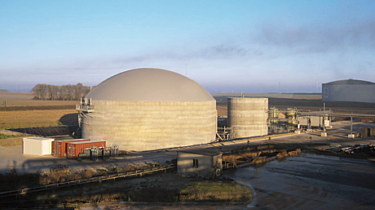Biological wastewater treatment: Anaerobic vs Aerobic and other systems
When integrating biological treatment processes, distinguishing between methods such as anaerobic and aerobic digestion is crucial as they serve different roles and have unique benefits and requirements. Depending on the organic pollution, different treatment methods can be used.

When integrating biological treatment processes, distinguishing between anaerobic and aerobic methods is crucial as they serve different roles and have unique benefits and requirements. Depending on the organic pollution, different treatment methods can be used. With high-strength wastewater (Dairy, Potato, Brewing effluent) anaerobic treatment can unlock the energy potential hidden in the organic pollution. Where the organic load is less, aerobic treatment will be a suitable solution to comply with discharge regulations or prepare the effluent for reuse. But combinations often result in best of both solution.
What is biological wastewater treatment?
Biological wastewater treatment is an eco-friendly method that uses microorganisms such as bacteria, nematodes, and other small organisms to break down organic pollutants in wastewater. This process mimics natural ecosystems and plays a crucial role in secondary treatment processes, where the largest amount of organic material is removed. The microorganisms feed on organic waste, breaking it down into simpler compounds such as water, CO₂, and biomass. This biological approach ensures efficient water purification without the use of harmful chemicals.
Biological wastewater treatment technologies and systems
At Waterleau, we offer a wide range of biological wastewater treatment technologies tailored to the specific needs of industries and municipalities. These systems utilize the power of microorganisms to efficiently and sustainably treat wastewater. Below are some of the key technologies we provide:
- Aerobic Treatment Systems
Aerobic processes, such as activated sludge systems and trickling filters, use oxygen to promote the growth of microorganisms that break down organic matter. These systems are highly effective for removing biodegradable organic compounds and are commonly used in secondary treatment. - Anaerobic Treatment Systems
Anaerobic processes, like anaerobic digestion and Upflow Anaerobic Sludge Blanket (UASB) reactors, operate without oxygen and are ideal for treating high-strength industrial wastewater. These systems produce biogas (mainly methane) as a by-product, which can be harnessed as renewable energy. - Combined Systems
Combined aerobic and anaerobic systems offer a versatile solution for wastewater treatment, enabling the efficient removal of organic matter while optimizing energy recovery. These systems are particularly suited for complex or variable wastewater streams. - Membrane Bioreactors (MBR)
MBR systems combine biological treatment with advanced filtration using membranes. These systems ensure high-quality effluent with minimal space requirements, making them ideal for applications with stringent discharge standards. - Lucas TS Technology
Our proprietary Lucas TS system integrates biological treatment with innovative sludge reduction, improving process efficiency and reducing operational costs. This technology is particularly effective in reducing the volume of residual sludge, addressing one of the key challenges in wastewater management. - Sequential Batch Reactors (SBR)
SBRs are flexible systems that treat wastewater in batches, allowing for precise control of treatment cycles. They are highly effective for handling variable loads and achieving high removal rates for organic matter and nutrients.

Anaerobic Treatment:
- Process Description: Anaerobic treatment involves the breakdown of organic matter in the absence of oxygen by anaerobic bacteria. It typically takes place in a closed reactor known as an anaerobic digester.
- Biogas Production: One of the major benefits of anaerobic digestion is the production of biogas, which is a mixture of methane and carbon dioxide. This biogas can be captured and used as a fuel source, providing an energy recovery aspect to the wastewater treatment.
- High Organic Load Efficiency: Anaerobic processes are highly effective at treating wastewater with high organic loads, such as those found in dairy effluents, making them economically favorable.
- Lower Sludge Production: Compared to aerobic processes, anaerobic treatment produces less biological sludge, reducing the burden and cost associated with sludge handling and disposal.
- Operational Considerations: Requires careful control of pH, temperature, and toxicity to maintain microbial health and activity. The process is slower than aerobic treatment and may require pretreatment to remove inhibitors.

Aerobic Treatment:
- Process Description: Aerobic treatment uses oxygen and aerobic bacteria to decompose organic matter in wastewater. This process often takes place in an activated sludge system, where air or oxygen is bubbled through a mixture of wastewater and sludge.
- Sludge Handling: Aerobic processes generate more sludge than anaerobic processes. This sludge needs to be regularly removed and treated, which can increase operational costs.
- Energy Requirements: Aerobic treatment requires significant energy to aerate the wastewater, which can make it more costly than anaerobic treatment in terms of energy consumption.
- Faster Process: The aerobic process is generally faster than anaerobic digestion and can be more effective at reducing pathogens in the effluent.
- Application Suitability: Best suited for lower-strength wastewaters and is commonly used as a secondary treatment step following anaerobic digestion for further reduction of organic matter.
Combined anaerobic-aerobic treatment plants.
In a dairy water recovery plant, these processes might be used in tandem:
- Anaerobic First Stage: Anaerobic digestion can serve as the primary treatment for high-strength dairy wastes, reducing the organic load significantly while also generating biogas for energy recovery.
- Aerobic Second Stage: Following anaerobic treatment, the effluent can be further treated aerobically to remove any remaining organic material and to polish the effluent to meet discharge standards or be suitable for reuse.
Anaerobic digestion vs Aerobic digestion
While both anaerobic and aerobic digestion are critical technologies for biological wastewater treatment, they differ significantly in their processes, requirements, and outcomes. Here are the key differences:
Oxygen Requirement:
- Anaerobic Digestion: Operates in the absence of oxygen.
- Aerobic Digestion: Requires a continuous supply of oxygen to sustain microbial activity.
Energy Usage and Production:
- Anaerobic Digestion: Produces biogas (methane) as a by-product, which can be used as a renewable energy source. Energy input is minimal.
- Aerobic Digestion: Consumes significant energy for aeration systems but does not produce biogas.
Treatment Focus:
- Anaerobic Digestion: Best suited for high-strength industrial wastewater with high organic loads.
- Aerobic Digestion: Commonly used for municipal wastewater and wastewater with lower organic content.
Sludge Production:
- Anaerobic Digestion: Generates less residual sludge, reducing disposal costs.
- Aerobic Digestion: Produces a higher volume of sludge, requiring additional handling.
Process Speed:
- Anaerobic Digestion: Slower process, often requiring longer retention times.
- Aerobic Digestion: Faster treatment due to the higher activity rate of microorganisms.
Both technologies are essential components of Waterleau’s smart wastewater solutions, and the choice between them depends on the specific requirements of the wastewater being treated.
Other news

Financing the Future of Water
New €50 million joint-venture partnership with SFPIM and Ethias to help industrial and municipal clients finance sustainable water projects off balance sheet.

Waterleau is heading to Drinktec 2025 in Munich!
Visit us at our Booth B5-368 and enjoy a delicious Belgian craft beer for our 25th anniversary! From 15 to 19 September in Munich!

Waterleau at Sustainable Aviation Fuel Summit Brussels
Discover why Waterleau joined the SAF Summit — and how water plays a key role in fueling sustainable aviation
Find your local contact
Our expertise is always within reach. Digital communication has cut long distances short, but we advocate the traditional way of sharing insights.
Contact us today. We are looking forward to help you reach your sustainable development goals.




